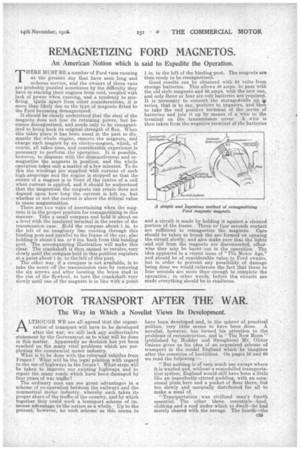REMAGNETIZING FORD MAGNETOS.
Page 9

If you've noticed an error in this article please click here to report it so we can fix it.
An American Notion which is said to Expedite the Operation.
THERE MUST BE a number of Ford vans running at the present day that have Seen long and arduous service, and the owners of these vans are probably puzzled sometimes by the difficulty they have in starting their engines from cold, coupled with lack of power when running, and a tendency to misfiring. Quite apart from other considerations, it is more than likely due to the type of magneto fitted to the Ford becoming demagnetized. It should be clearly understood that the steel of the magnets does not lose its retaining power, but becomes demagnetized, and needs only to be rernagnetized to bring back its original strength of flux. When this takes place it has been usual in the past to dismantle the whole engine, remove the magnets, and charge each magnetby an electro-magnet, which, of course, all takes time, and considerable experience is necessary to perform , the operation. It is possible,. however, to dispense with the dismantlement and remagnetize the magnets in position, and the whole operation takes only a matter of a few minutes. To do this the windings are supplied with current of such high amperage and the engine is stopped so that the centre of a magnet is in front of the centre of a coil when current is applied, and it should be understood that the Magnetism the magnets can retain does not depend upon how long the current is left on, but whether or not the current is above the critical value to cause magnetization.
There are tuo ways of ascertaining when the magneto is in the proper position for rem agnetizing in this Manner. Take a small compass and hold it about on a level with the insulated terminal in the centre of the transmission case. Hold the compass about 1 in. to the left of an imaginary line running through this binding post and parallel to the frame of the car, also bolding it about 5 ins. or 6 ins, back from this binding post. .The accompanying illustration will make this clear. The crankshaft iS then,. caused to revolve very slowly until the compass held in this position registers at a.point about 1 in. 'to the-left of this post. .
The other way, if a compass is not available, is to take the cover off the transmission ease by removing the six screws and 'after locating the brass studin the rim of the flywheel, to turn the crankshaft very slowly until one of the magnets is in line with a point
1 in. to the left of the binding post. The magnets are then ready to be remagnetized. Good results can be obtained with 24 volts. from storage batteries. This allows 48 amps. to pass with the old style magneto and 96 amps. with the new one, and only three or four six-volt batteries are required. It is necessary to connect the storageseells up •ie. series, that is to say,. positive to negative, and then to take the end positive terminal of the series of batteries and join it up by means of a Wire to the terminal on the transmission cover. A . wire is then taken from the negative terminal of pe batteries and a circuit is made by holding it -against a cleaned portion of the frame. Three or for seconds contact are sufficient to rernagnetize the magneto. Care should be taken to break the arc formed on opening the circuit slowly, and also make sure' that the lights and coil from the magneto are disconnected, otherwise they may be burnt out in the operation. The idea appeared in a recent issue of " The Motor Age," and should be of considerable value to Ford owners, but in order to prevent any possibility of damage being done we would reiterate the fact that three to four seconds are more than enough to complete the operation ; in other words, before tint circuits are made everything should be in readiness.






















